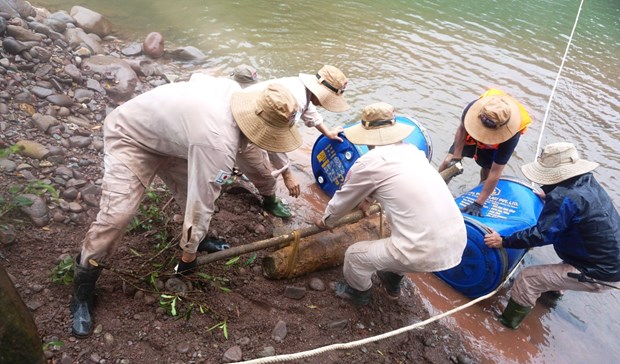Three war-time bombs deactivated in Quang Binh province
The Mines Advisory Group (MAG) on December 2 said its mobile team in the central province of Quang Binh had coordinated with the provincial Military Command and local authorities in safely moving three war-time bombs found in residential areas.

After receiving alerts from local residents, the MAG’s mobile team and competent forces deactivate the bombs and move them to the designated area for safe destruction. (Photo: VNA)
The Mines Advisory Group (MAG) on December 2 said its mobile team in the central province of Quang Binh had coordinated with the provincial Military Command and local authorities in safely moving three war-time bombs found in residential areas.
One of the three bombs, a MK81, was found in Dan Hoa commune (Minh Hoa district) on November 30. The bomb’s location is only 500m from Bai Dinh village’s cultural house and Dan Hoa primary school.
The other two were discovered on November 27 by locals. Both are M117 bombs, with one in Minh Hoa district and the other in Bo Trach district.
After receiving alerts from local residents, the MAG’s mobile team and competent forces deactivated the bombs and moved them to the designated area for safe destruction.
Since the beginning of this year, the MAG team has handled 285 pieces of unexploded ordnance (UXO). The team’s operation is supported by the US Department of State and the Japanese Government.
Decades after the end of war, Vietnam still suffers from the deadly threat from bombs, mines and UXO left by war.
According to the Vietnam National Mine Action Centre, all 63 provinces and centrally-run cities in Vietnam are contaminated with UXO, with 6.1 million hectares of land in total (18.41% of the country’s acreage) affected. It is estimated that between 600,000 – 800,000 tonnes of UXO are still hidden underground, and 110,000 people have so far become victims of UXO./.
VNA
 Provincial Charity Club for Children with Cancer launched
Provincial Charity Club for Children with Cancer launched
 VGCL surveys "Better Jobs" program in enterprises
VGCL surveys "Better Jobs" program in enterprises
 Reducing GHG emissions contributes to sustainable development
Reducing GHG emissions contributes to sustainable development
 Many practical ideas made at Social Insurance’s forum listening to people's opinions
Many practical ideas made at Social Insurance’s forum listening to people's opinions
 Binh Duong General Hospital succeeded in VABB
Binh Duong General Hospital succeeded in VABB
 Traffic safety in road transport business strengthened
Traffic safety in road transport business strengthened
 Binh Duong has three teachers honored as outstanding national ones
Binh Duong has three teachers honored as outstanding national ones
 Flexible solutions crucial to develop carbon credit market: experts
Flexible solutions crucial to develop carbon credit market: experts
 Supporting policies of land for ethnicity to promote emergence from normal lives
Supporting policies of land for ethnicity to promote emergence from normal lives
 Province prepares Tet for workers
Province prepares Tet for workers




